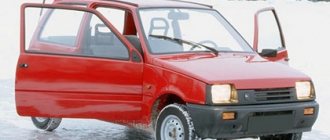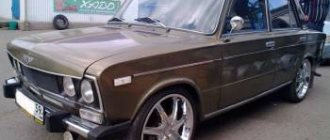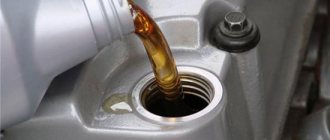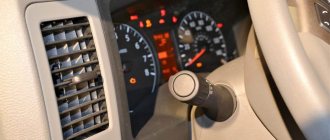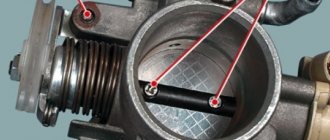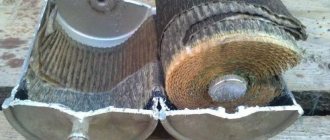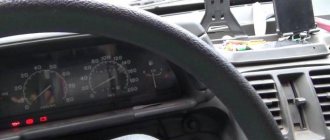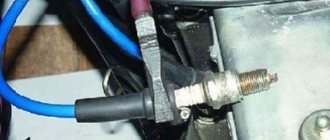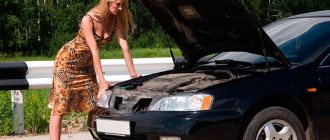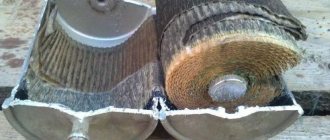Some drivers have noticed that after warming up the engine begins to stall, that is, its power drops due to a malfunction of one of the internal combustion engine cylinders. In addition to a noticeable deterioration in speed characteristics, as the speed increases, you can notice body vibrations, significant fuel consumption and a variable number of idle speeds. Where this problem comes from and how to solve it needs to be clarified.
About engine tripping
The term “troit engine” appeared in the Russian language when citizens began to use cars with a 4-cylinder engine. If any of the 4 cylinders stopped working properly, they said that the engine was failing. Now the same designation is used even for 6- and 12-cylinder internal combustion engine models, although this is not an entirely accurate designation of the malfunction.
The peculiarity of the problem is that it is detected only after the engine is started and the parts are significantly heated.
During warm-up, internal parts may change their characteristics and dimensions, causing damage to occur while driving. Since 1 cylinder is malfunctioning, driving even short distances becomes unforgettable: body vibration in the first 2 minutes will already prove that the car is not capable of moving. However, tripling may disappear and then reappear.
Spark plug
The main thing is that you cannot immediately determine why one of the cylinders failed. That is why even experienced car enthusiasts and experienced drivers can delve into the insides of their car all day long, but in the end they will not achieve any result. You have to check everything several times.
How can you speed up this procedure and pay attention to the most important problems. Most often, the engine stalls when warming up due to faulty spark plugs.
One of the causes of malfunction are spark plugs if:
- The contacts and insulation of the spark plugs are covered with oil or black soot.
- The spark plugs or their contacts are damaged.
The problem is this:
- excess oil enters the combustion chamber from the crankcase;
- the air-fuel mixture located in the combustion chamber does not ignite due to a faulty spark plug.
The solution to the problem is simple: you need to replace the entire set of spark plugs, and then check the remaining parts next to them for damage. Change the oil and start the engine. If the tripping has stopped, then everything has been done correctly; if not, we need to look for other sources of the problem.
Common causes of engine stalling at idle
Separately, the most common problems leading to engine failure without an applied load should be described.
The idle speed controller is faulty
The problem is typical for injectors and modern internal combustion engines. A smart unit often fails due to mechanical damage, natural wear, or incorrect calibration.
The electronic regulator has several weaknesses:
- signal sensors;
- control relays;
- fuse system.
Throttle valve dirty
A sensitive throttle often becomes the reason for visiting a service station. In the idle position, the damper on most designs opens only partially. When carbon deposits appear on the surface of the valve, the passage opening decreases. The negative effect reduces the idle speed or may cause engine failure.
To fix the problem, just clean the mechanism and put it back in place.
Idle fuel jet clogged
Frequent breakdowns in carburetor engines. The fuel jet is a screw with a thin hole drilled inside. If low-quality fuel is used, or rust appears in the gas tank, the line becomes clogged, which prevents the free passage of liquid.
Fuel pump malfunctions
The engine behaves similarly when this part wears out or malfunctions. When the internal combustion engine is idling, the working part of the unit rotates slowly, the pressure in the fuel system is minimal. When the pump impeller wears out, its performance drops noticeably. The effect is especially noticeable at idle speed.
Fuel filter dirty
The following problem is common to all power plants, regardless of the design and type of fuel consumed. When the filter element is clogged, the throughput of the device is reduced to a minimum. An amount of fuel that is insufficient to maintain stable engine operation enters the combustion chamber.
Malfunction of the mass air flow sensor
The mass air flow sensor is responsible for reading and adjusting the supplied air flow. If the sensor transmits incorrect information, the ECU will not adjust the fuel mixture correctly. Consequently, the power unit will fill or lack gasoline.
Contamination of the crankcase ventilation system
It may become clogged due to the use of low-quality oil, fuel or lack of maintenance.
When excess pressure appears inside the crankcase, the system stops functioning normally, excess pressure is created in the engine and the internal combustion engine stops working.
Possible problem options
Further searching for the cause of the problem becomes more difficult, since you will have to check a dozen parts for damage:
- There is additional air leakage into the combustion chamber; you need to check the hoses and wiring.
- There is a breakdown somewhere in the wiring; you should check their insulation for damage.
- The problem is in the capacitors - check, replace if they are faulty.
- Inspect the valves for burnouts.
- Next, you need to inspect the pistons and their rings. If there are broken rings or burnt pistons, the problem may be with them.
That's all there is to inspect first. Next, you should go through and inspect the following parts for defects: carburetor, valve stem seals, valve rockers, air filter, entire ignition system, cylinder head gasket.
If it continues to malfunction after a detailed inspection of all parts and replacement of all damaged components, then you need to contact a service station for the help of specialists and computer diagnostics of the car. The cause of the malfunction is extremely difficult to find, so even finding it may take not several hours, but several days. In rare cases, even a trip to the service center may end in nothing.
avtoexperts.ru
A rather unpleasant and at the same time familiar situation to many is when the engine stops at idle (XX). This is especially annoying for drivers when the engine stops working at traffic lights or when driving slowly in a traffic jam. A similar malfunction is observed on both carburetor and injection engines, both on cold and warm engines. Today in our article we will try to analyze the reasons for the occurrence of such a malfunction and possible ways to repair it.
Inspection of the engine compartment
Prerequisites for malfunction
The engine may start stably, but then it begins to shake, oscillate, and the engine stalls. Such a malfunction may have reasons such as a strong layer of dirt on any elements, or a failure of sensors, components or mechanical devices involved in the operation of the engine at idle.
In cold weather, during short movements, the engine hardly warms up, which leads to the formation of low-temperature deposits. A sticky mixture accumulates in the crankcase ventilation system, deposits of which settle in the throttle assembly, which leads to jamming of the damper. In general, tarry deposits are a consequence of the fact that the car is operated on gasoline of poor quality.
Deposits on the throttle valve
Reasons for failure of gasoline engines at XX (injection and cars with a carburetor):
• Failure of the idle air controller (IAC);
• The throttle valve is out of adjustment or dirty;
• The XX carburetor solenoid valve does not work, or there is a break in its power supply circuit;
• The idle jet or its channel is dirty;
• The float is stuck in the closed position in the carburetor float chamber;
• Fuel injectors are faulty;
• The fuel pump is faulty (mechanical or electrical);
• Severe contamination of the fuel or air filter;
• “Overgrowing” of the crankcase ventilation system;
• Faulty speed sensors, throttle position sensors (TSP), failure of mass air flow sensor;
• Air leakage at the intake manifold or in the throttle body;
• Oxygen sensor malfunction.
More details about the causes of the malfunction
If on carburetor engines the reasons are mainly caused by contamination of the elements or a malfunction of the mechanical part, then on engines with injection, problems with the lack of idle can also be associated with electronics.
RXX
If the IAC malfunctions, the engine will either stall immediately after starting, or the speed will begin to fluctuate. This is due to the fact that the regulator is installed in the bypass channel of the throttle assembly, and if the regulator is stuck in the extended position, then its rod blocks the air supply channel, which leads to the engine stopping.
Soot on IAC. Should be cleaned.
Throttle valve
A similar situation occurs when the throttle valve is contaminated, when it cannot completely shut off the air supply channel. The cause of its contamination is most often plaque entering through the crankcase ventilation system, as well as the use of low-quality fuel and a dirty air filter.
Dirty throttle valve
Electrovalve and jet XX
If the return stroke solenoid valve fails, or if its power supply is interrupted, it is unable to draw in the jet that closes the XX channel and the engine stops.
The same thing happens when the hole in the XX jet becomes clogged, causing the engine to stall.
Idle jet of carburetor VAZ 2108, 2109
Float in carburetor
If the float gets stuck in the upper position (blocking the shut-off valve needle), the gasoline supply stops and the engine stalls. Interruptions in engine operation can also be due to contamination of the fuel filter at the inlet to the carburetor due to accumulated deposits or small debris.
Solex carburetor
Injectors
Interruptions and even the absence of idle fuel can also be caused by a failure of the fuel injectors, either due to their mechanical part, or due to a malfunction in the engine ECU system.
Failure Daewoo Nexia injector. Photo – Drive2
Gasoline pump
If the fuel pump malfunctions, the fuel supply stops or is supplied in small quantities, which also leads to the engine stopping.
Dirty fuel pump screen
Filter
Severe contamination of the fuel or air filters leads to a change in the composition of the fuel mixture (re-enrichment or leanness of the mixture) and, as a result, interruptions in operation or the engine may stall.
Fuel filter
Crankcase ventilation
When the crankcase ventilation channels and oil separator are heavily contaminated, the pressure of crankcase gases increases, which literally choke the engine, leading to a floating speed or engine stop.
Sensor system
Unstable operation of an injection engine, even to the point of stopping it, can occur due to a malfunction of electronic sensors, such as mass air flow sensors, air sensing sensors, and IAC.
TPS and IAC
Air leak
If changing the sensors does not change the situation, then there may be air leaks at the intake manifold, the connection of the intake manifold to the vacuum brake booster, or insufficient gasoline pressure in the fuel rail.
Air leak on the intake manifold
If the oxygen sensor fails, the XX engine also malfunctions.
Oxygen sensor - Lambda probe
In addition, on any engines, it is recommended to check the ignition system: armored wires, spark plugs, coil/s, distributor, as well as the low-voltage power circuit.
• Diesel
The reason why a diesel engine stops at idle is most often either wear of the fuel injection pump elements or the appearance of air in the power system.
Repair methods:
• Carburetor engines
Cleaning channels and jets, checking the fuel level and serviceability of the idle air valve, as well as adjusting quality and quantity. Replacement of fuel and air filters.
Carburetor cleaning
• Injection engines
On these engines, tar deposits accumulate in the narrowest places. Thus, contamination of the thin holes in the injector nozzles changes the composition of the mixture towards depletion, which leads to the fact that instead of a full portion of fuel, only a few drops get into the cylinders. This leads to unstable operation of the engine, even to the point of stopping.
To restore the operation of the injectors, they are washed either on the engine or when they are dismantled at a special stand, where they are washed and calibrated, as well as faulty ones are rejected.
Cleaning injectors
Incomplete closing of the throttle valve also leads to unstable engine operation, or the engine begins to stall. The damper cannot take its place due to accumulated dirt that needs to be cleaned. The so-called “Carburetor Cleaner” in aerosol packaging has proven itself well for cleaning, after which the throttle is purged with compressed air.
• Diesel engines
To restore the operation of the twentieth, preventive repairs of the high-pressure fuel pump (HPF) are carried out, where plunger pairs and other worn pump elements are checked and, if necessary, replaced.
Air leaks in the fuel injection pump are also eliminated.
A few more words
In order not to find yourself in a situation where the engine stalls at the most inopportune moment, try to adhere to the following recommendations:
• Use only high-quality gasoline;
• Periodically carry out diagnostics of the power supply and chemical systems;
• Replace engine oil and filter in a timely manner;
• Warm up the engine at low temperatures before driving.
How to check the wiring?
There is one, rather risky way to find the cylinder: disconnect the high-voltage cables from the running engine one by one. By disconnecting the power from the ignition, it will be possible to understand which of the cylinders is not working, thereby significantly narrowing the search.
However, there is a risk of electric shock. It is not fatal, but it is quite painful, so you need to take care of your protection. You can start working if you first put on rubber gloves and stand on a rubber mat. Then follow these tips:
- Turn on the engine, raise and secure the hood.
- One by one, you need to disconnect the cables from the spark plugs. You must hold on to the insulation, not the tip of the wiring; you must not touch the body while removing the live wiring.
- If you turn off the slave cylinder, you will hear that the sound of the engine running has changed. But if it is faulty, then nothing will happen.
List of possible problems
Problem. After filling up with new gasoline, the check engine light started to come on, the car managed to warm up, but it started to stall after about 20-30 minutes of driving. Answer. In this case, it is not the ignition; the power supply and gas distribution system can also be discarded. It is necessary to check the integrity of the carburetor and fuel supply system. Replacing gasoline sometimes does not solve the problem.
This happens in some foreign cars with automatic transmissions. If you can’t find anything on your own, you should go to a service station; computer diagnostics should reveal the problem. There is no need to agree to replacing components without a reason, if the option will only possibly solve the problem. It is recommended to visit another service station.
Problem. Gasoline engine, injection type, misfires are shown in different cylinders during diagnostics. The spark plugs were replaced, all parts of the gas distribution system were cleaned and checked. Answer. The breakdown may be in the distributor cover or the ignition power supply: wiring, coils. It remains to check the fuel system as well.
Engine tripping is a very unpleasant defect that is difficult to get rid of. It is necessary to check all the above components, replace damaged parts - perhaps this will solve the problem. If all attempts are in vain, then you should go to a service station for diagnostics.
Cars suffer many breakdowns during operation, and one of the problems that most often and most worries owners is why the car stalls and does not. Let's consider the main causes of such phenomena, as well as possible actions to prevent them.
We carry out diagnostics and repair work on the carburetor ourselves
You can take advantage of excellent carburetor work if you know its design and have already dealt with simple repair processes. Otherwise, we do not recommend that you try recovery on your own. Ultimately, such repairs will cost much more than they could cost from specialists. If you have experience and confidence in your skills, you can use the advice of specialists to perform a high-quality restoration of your car. Among the main work that will have to be carried out, the following processes can be identified:
- remove the carburetor cover with the air filter and try to start the car, as it warms up, lower the choke and look at the position of the dampers, perhaps adjusting them will be enough to restore the car’s operation;
- if this does not help, look at the functioning of the fuel system; perhaps the fuel pump stops pumping fuel after a certain period of normal operation;
- also examine the cooling system, regardless of what the gauges on the dashboard say, look at the antifreeze level, make sure the thermostat is working correctly;
- you can also change the air and fuel filters to make sure that fuel and air enter the carburetor without problems and in sufficient quantities;
- the last stage of work is the removal and disassembly of the carburetor to install a repair kit, new gaskets, membranes and other parts, as well as to clean this device from contamination.
Cars with gasoline engines
A gasoline engine may not start after warming up quite often, especially when operating in low temperatures. The fact is that the fuel remaining in the chamber begins to evaporate quickly due to elevated temperatures. Vapors fill all cavities, including the carburetor, manifold, and air filter. As a result, fuel levels in the float chamber decrease and gas plugs occur. The duration of this process depends on the design of the fuel system and on the external temperature conditions.
That is, the reason why a gasoline engine does not warm up after warming up lies in excessive evaporation of gasoline and the formation of an enriched fuel mixture.
Cars with carburetor engines (VAZ 2101,2102,2103,2104,2105,2106,2107)
The reasons for this malfunction can be very diverse, but the 2 main ones are a malfunction of the fuel system and the ignition system. The search must be carried out step by step, then the desired result will be obtained. The reason for unstable engine operation is the over-enrichment or depletion of the fuel mixture entering the engine cylinders when the gas pedal is pressed. This should be taken into account when diagnosing faults.
Indirect signs by which you can determine the causes of unstable engine operation when you press the gas pedal.
1. When starting from a stop or idling, a “failure” is felt when you smoothly press the gas pedal. During acceleration and further movement, the engine runs stably.
2. While driving at low and medium speeds, when you press the gas pedal, the car jerks with a possible engine stop. This defect disappears when you press the gas pedal harder.
3. The engine stalls or there is a “failure” when you sharply press the gas pedal at idle, when starting from a stop, accelerating and moving the car at different speeds.
- The accelerator pump is faulty. Eliminated by disassembly, inspection and replacement of damaged parts from repair. set.
- Insufficient gasoline level in the carburetor float chamber. Eliminated by adjusting the position of the float.
If the fuel level in the carburetor float chamber is excessive, the mixture is greatly over-rich and entering the engine cylinders can “flood” the spark plugs. If the level is insufficient, the fuel mixture, on the contrary, is lean and when pressing the gas pedal, the engine does not receive the required amount of fuel and the car slows down instead of accelerating.
Cars with diesel engines: causes of malfunction and solutions
Considering the question of why a diesel engine does not start well after warming up, it can be noted that this problem when heating occurs among many owners of cars of all classes. Unlike a gasoline engine, the problems of a diesel engine are not so obvious and trivial.
This problem is common among domestic and imported cars. The reasons for this phenomenon, when the machine refuses to work, are varied:
- Problems with the fluid temperature control sensor. The sensor that records and displays information about the coolant temperature has failed, resulting in the fuel mixture being supplied incorrectly.
- If the electronic device does not function correctly or breaks down, it receives an incorrect impulse, the fuel supply adjustment is disrupted, and after warming up the engine does not start.
- Depressurization of injectors when heated, through which diesel fuel leaks over time. It is found in excess in the combustion chamber, which interferes with the normal operation of the engine. You need to take out the injector and see how wet it is.
- Incorrect operation of the fuel injection pump when heated; in diesel engines this element is often subject to malfunctions. The problem is solved by cooling the rear area of the pump and trying to start again, and the way out of the situation is to replace the plunger pair and bushings.
- Malfunctions of the injector sensors responsible for fuel injection. As a result, the injection angle changes; to solve the problem, it is necessary to correctly adjust the direction. It is recommended to check the operation of the idle speed and pressure regulators.
In fact, there are few common causes and problems of hot starting, and if you know the right solutions to eliminate them, you can avoid unforeseen consequences and make the driving process more comfortable.
Don’t immediately panic and go to a service station to find out why the car won’t start. Problems may lie in trivial things.
The engine starts and stalls: reasons
In practice, this happens when the driver was able to start the car normally, and it began to work productively, but after the sensor recorded the current operating temperature, the engine stalls. Of course, this not only causes discomfort for drivers, but is also an unpleasant situation that requires establishing the exact reasons and taking specific actions.
Here are some common reasons why a motor may behave this way, and why it refuses to run hot:
- The car started up calmly and worked well, but then the engine began to behave strangely - it was malfunctioning and had trouble starting. This can only indicate that you filled the car with low quality or defective fuel. To solve the problem, you need to drain it, blow out the system and then replace the filter. It is recommended to replace the spark plugs. This reason why the engine refuses to work is a reason for every driver to behave prudently and always demand a receipt at the gas station (in case of subsequent problems, he will be able to voice his claims at the gas station).
- Another common reason when a car, or more precisely, the engine, stalls while warming up is the presence of malfunctions in the throttle valve area. The situation can be corrected through cleaning. Another problem may be the element position sensor. The solution is obvious - you will need to replace the TPS; the procedure can be done with your own hands in a short time.
- The car has normal fuel, but when it’s “hot” it stops functioning. If this phenomenon occurs with your car, you need to notice the air filter. To perform the work responsibly and efficiently, you should contact the service center specialists.
- A similar situation can occur if the car’s air filter is clogged. The difficulty is connected with the fact that the engine needs to “breathe”, but there is nothing to do this during warm-up. The fact is that the air mixture becomes too rich in fuel, which leads to the engine stalling. In this situation, it is necessary to replace the air filter.
- A problem with the fuel pump is a common malfunction in which the engine refuses to work. This picture is typical for many engines. The fuel pump can be repaired, but many experts advise replacing it with a new unit.
- There are situations when the generator “refuses” to provide the required charge to the car battery. If this happens, the best and first way to help is to tighten the drive belt. If such a measure does not help improve the situation, this may indicate a failure of the generator. If this breakdown occurs, restarting the unit will be impossible due to a dead battery.
Summary
On modern cars, if the engine is malfunctioning and stalls “hot” when heated, special sensors can signal malfunctions. If you do not understand their location or meaning, you must contact a service station.
The failure of the power unit to operate when cold or after warming up to a certain temperature may indicate a fairly wide list of possible problems. The engine begins to stall both suddenly and to work unstably in different modes, after which the internal combustion engine stops.
In this article we will talk about the reasons why the engine stops at idle, as a result of which a warm engine stalls, why a car with a hot engine stalls while driving, etc.
Read in this article
Common problems on all engines at idle
There are a number of problems that are typical for all power plant designs. Due to the design features of internal combustion engines, at idle speed, malfunctions and interruptions in operation stability may occur.
Problems with carburetor engines
- Idle jet clogged. When using low-quality fuel, thin passages can become clogged with debris or grains of sand, which causes unstable engine operation.
- Low permeability of air and fuel lines. If there is insufficient amount of fuel or oxygen, the power plant does not hold idle well and may stall.
- Incorrect ignition setting or system problem.
Why does the injector stall at idle?
The injector is characterized by the presence of factors:
- incorrect operation of the computer;
- clogged injectors;
- failure of individual sensors.
Diesel won't idle
They are capricious due to the following reasons:
- problems with the injection pump system;
- insufficient purity of diesel fuel;
- breakdowns within the fuel or air line system.
They may stall in winter due to fuel freezing.
A hot engine stalls while driving or idling
Let's start with the fact that the symptoms and signs of this problem can manifest themselves in different ways. Quite often, the power unit may stall in idle mode, and unstable operation and complete stop of the internal combustion engine often occurs after the engine has warmed up.
First of all, diagnostics should begin with checking the spark plugs and their condition. At the same time, high-voltage armored wires should also be checked. This must be done because there may be weak sparking or no spark at all on the spark plug electrodes. Interruptions in the spark lead to serious malfunctions in the operation of the engine, as a result of which both the cold unit and the engine stalls after warming up. Replacing spark plugs and high-voltage wires often helps solve the problem.
Another common situation is when the engine stalls hot or cold immediately after starting it. In this case, on many modern cars with an injection power system, you should check the idle speed sensor. The failure of this element of the electronic engine control system often leads to the fact that the engine is simply unable to operate at idle speed.
The engine stalls at idle: solving the problem
When making repairs yourself, you may need to carry out the following actions:
- complete replacement of sensors;
- restoration of the performance of individual elements, whose life can be extended;
- preventive work to avoid recurrence of problems of this kind.
Complete replacement of broken equipment is required when some devices break down. When the engine stalls, it cannot be avoided if the reason lies in faulty throttle or idle position sensors. Often they prefer to replace the throttle valve itself. The carburetor or injector is replaced only if cleaning does not help. If there is no need to completely replace any parts, it is the same thing that they resort to cleaning the throttle from accumulated dirt. Cleaning the carburetor or injector often helps, because the fuel supplied to the engine is not always of high quality and the filters do not always cope.
The engine turns off periodically when idling
It does not play any role, the car engine turns off sometimes or with a certain regularity - the causes and solutions to the problem do not change. The main thing to remember is that even a small frequency of occurrence of a problem is a sign of poor performance of the car’s internals.
The car starts to “cough”, the engine stalls after starting
Blocks to check:
- ignition system;
- correct setting of mixture formation;
- quality of the fuel used.
The car stalls at idle even though it starts
If the car, after starting the engine, jerks when you press the gas, the speed is unstable, and then drops completely and it stalls, then the fault probably lies with the fuel pump or dirty filters. You can learn more about the problem from the video.
The car starts and stalls immediately after the starter is turned off.
If this problem occurs, it is recommended to check the serviceability and calibration of the modules:
- immobilizer setting;
- correct setting of the alarm mode;
- serviceability of the ignition switch.
Car stalls at idle when cold
The problem is common on the Opel Corsa car. The car cuts out at idle if the engine is not warmed up. The same thing happens with cars of other brands. The reasons are the same:
- unexpected vacuum leak;
- breakdown of spark plugs;
- rotor failure;
- problem with the distributor cap;
- The engine ignition timing is set incorrectly;
- malfunctions in the electronic control unit;
- problems with the recirculation valve;
- wear of power plant elements or mechanical damage;
- contamination of fuel injectors;
- Incorrect operation of the cold speed regulator.
Some faults can only be identified with the help of special equipment. Especially, incorrect operation of the electronic control unit (ECU).
The engine stops idling when the engine is hot
You have a relatively new Priora, you start the car and with the engine warm, press the gas, release the pedal and suddenly it starts to stall. This picture is familiar to many car enthusiasts who own this model and several others similar to it. The reasons why a car stalls when heated are not all, but they are similar to problems with a cold engine. Unless the cold speed sensor plays no role here.
The car was idling and stalled and would not start.
For example, the Chevrolet Lacetti stalled, the starter turns, but nothing helps. The reason is a faulty mass air flow sensor that needs to be replaced.
The engine stalls and stalls at idle
For example, a Mitsubishi Lancer 9 tries to start, but the engine starts to stall and turns off; most likely the coils, spark plugs or crankshaft are to blame. To fix the problem, you should contact a car service.
Symptom: Idle speed too high
There may be several problems.
- The throttle valve is stuck, the valve does not close to the desired position and too much fuel is supplied.
- A short circuit in the fuel pump line causes it to operate at higher speeds.
- The wrong jet is installed in the carburetor with an increased cross-section.
- The gas pedal goes down.
A small amount of oil enters the turbine.
Injection engine stalls at idle
The injector is what most likely brings together the owners of such different models as the Chevrolet Niva, Lada Kalina, VAZ 2115, 2112, 21093, 2114 and 2110, GAZ 3110 Volga, ZMZ 406, 409 or Renault Logan. Such engines come with 8 and 16 valves, but they stall no less often than carburetor engines, regardless of the number of the latter.
The main reasons are:
- incorrect operation of the idle control system;
- failure of the pump providing fuel supply pressure;
- lack of air suction;
- breakdown of the electronic control system for machine functions;
- breakdown of the mass air flow sensor or any other sensors;
- problems with the ignition system, in particular spark plugs.
Failures of sensors and electronic control systems are corrected at a service station. You can check the tightness of the connecting elements or the cleanliness of the filters at home, as well as clean the dirt or return the connectors to the desired position. The main signs of problems due to breakdowns of the latter type are when the car smokes and shakes.
Engine with carburetor stalls at idle
Owners of Gazelle 402 models, as well as VAZ 2105, 2006, 2107, 2109, are well aware when the engine with the carburetor stalls. This happens even with suction. The reasons for what is happening are somewhat different from those that cause cars to stop using injectors. Mainly distinguished:
- carburetor breakdown due to dirt;
- clogging of the fuel filter;
- clogging of the fuel pump filter element;
- breakdown of connecting hoses of the fuel supply system;
- solenoid valve malfunction;
- debris in the jet;
- failure of the idle speed sensor.
Most of the problems listed are easy to solve yourself - clean the filters and carburetor, replace the connections. But repairing the sensors will require the intervention of specialists. But solenoid valves can only be replaced.
Car stops idling after switching to neutral
An engine that stalls when switching to neutral is a classic Lanos problem. It begins to appear when the idle sensor fails and is solved by replacement.
Vehicle stalls at idle after driving through water
If the car stalls after driving through a large puddle, then most likely water has got on the sensors or the motor has experienced a water hammer. The last malfunction is typical for cars that drive through deep puddles with a low body height. If water gets on the wires or sensors - one thing, water hammer - another, the consequences are more serious.
The car stalls at idle when you turn the steering wheel
This malfunction is familiar to owners of Gazelles with a 405 Euro engine. It is caused by the inability to maintain the required number of revolutions. The solution is to tighten the throttle about a degree.
Engine stalls when stopped
Owners of the Land Cruiser 2UZ FE and Mercedes W212 models sometimes encounter engine failure when stopping. The culprit is a glitch in the immobilizer system, which can be easily fixed at a service center.
Car stalls at idle in traffic jam
If the car stalls not while moving, but when stopped, most likely its owner had to deal with one of four problems:
- fuel pump overheating;
- failure of solenoid valves;
- breakdown of ignition wires;
- voltage drop.
The easiest way to get rid of the malfunction is in the latter case - just raise the speed to a thousand or more. The first reason is often found in Tavria and is characterized by the fact that the revolutions float. The pump needs to be replaced.
The engine turns off at idle during braking
Damage to depressurization of the brake vacuum booster and depressurization of the VUT hose. To solve the problem, they are changed.
If the engine stalls, then starts normally
Such problems are consistently caused by electronic equipment. The user should check for errors in the BC, wiring, there may be problems with the relays and electronic units, sensors.
Diesel engine cuts out at idle
There is no particular difference in the reasons why a gasoline power plant turns off and, for example, a diesel VD615. Unless in the latter case the spark plugs play no role.
Gas car stops idling
Owners of a car with a 4th generation gas installation and an engine such as UMZ 4216 (found, for example, in Gazelles) have to face a problem in winter when, after a frosty night, the engine cuts out when switching from gasoline to LPG. This is due to hypothermia and the presence of a large amount of waste in the cylinder. Solved by reconfiguring the system and proper maintenance.
Other reasons why the engine stalls when hot
In addition to the above material, I would like to note a number of malfunctions that lead to a sudden stop of a hot engine while driving. The unit may stall while driving if the timing belt or chain is broken. This situation means that in most cases the power unit will require expensive repairs, since as a result of a break the valves are bent, piston defects and other damage to engine elements occur.
If the engine stalls while driving through deep puddles or other water obstacles, then there is a high probability of water getting into the cylinders or the elements of the ignition system getting wet. In the first case, water enters the combustion chambers through the air intake. Since water is incompressible, the engine is severely damaged, connecting rods bend, cracks appear in the cylinder block, etc. After a water hammer, there is usually a need to overhaul the engine. In the second case, the problem is not critical, since after removing the moisture, the functionality of the ignition system and power unit can often be restored.
Also, a car may stall when hot if there is too little fuel in the fuel tank. Quite often the engine stops when driving uphill. The fact is that during a long climb, the car is in a position for a long time when the fuel tank is tilted and the fuel level is not enough to supply through the fuel intake. It is quite obvious that in this case the engine will stall.
Let's sum it up
Fine cars with carburetor engines have become industrial history, but they are still widely represented on the roads. That is why you can use the ideas presented in this publication, since there are still a lot of carburetor masters, and you can find the necessary spare parts in stores. If your car has problems with the quality of the fuel supply system, it’s time to fix all these problems. You can quite easily obtain high quality operation of the power unit and fuel system if you simply take care of all the important components of the car.
